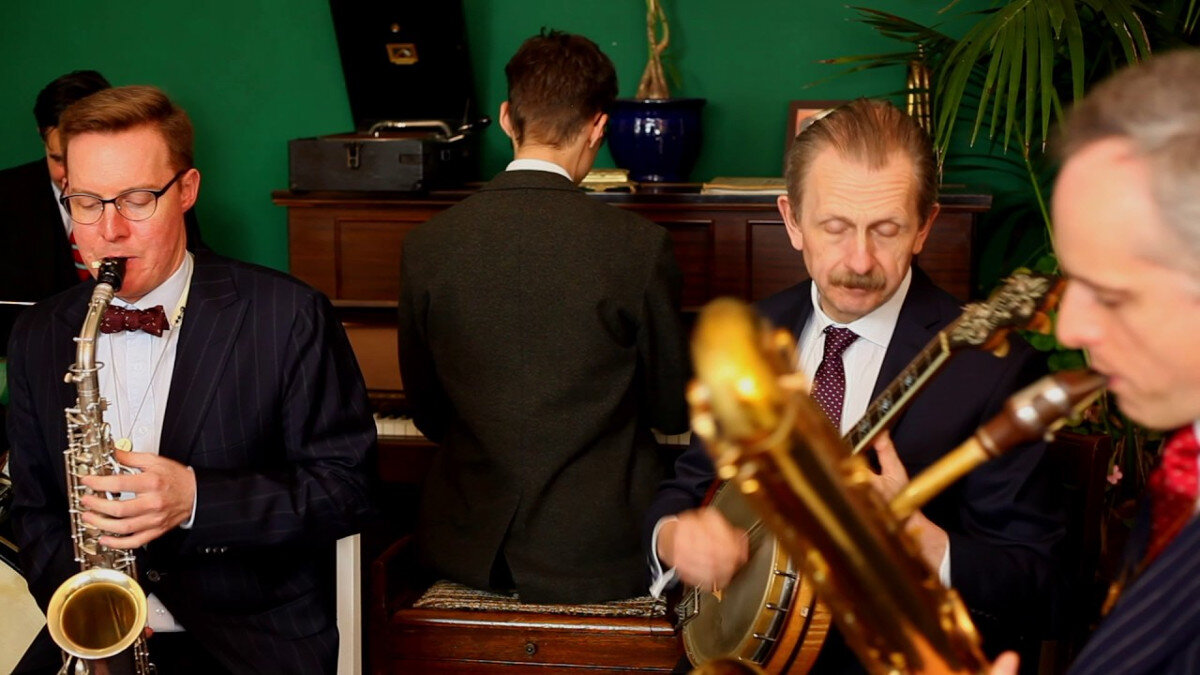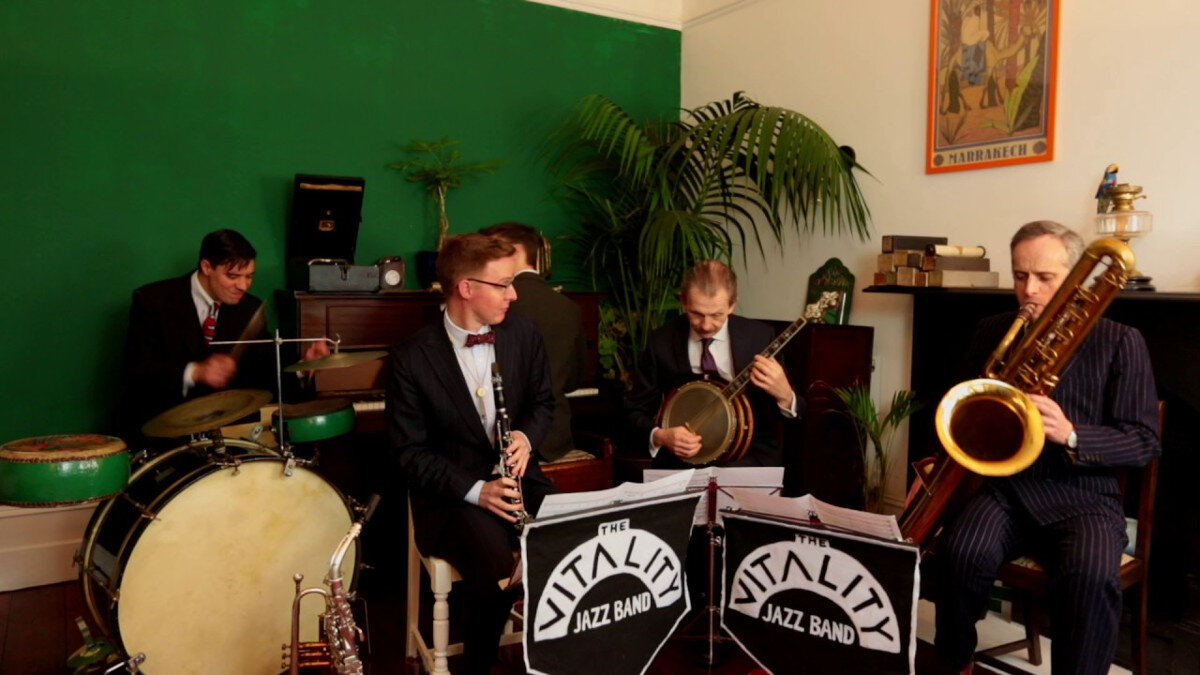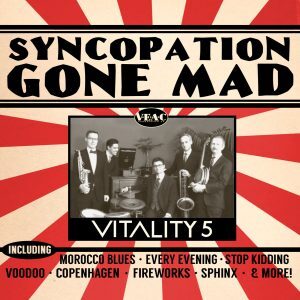For some musicians, good enough just ain’t good enough—only perfection will do. In his autobiography Trumpet on the Wing, Joe Manone remembers Bix Beiderbecke chastising his bandmates for rushing the second set, whenever they had girls waiting. “Damn you guys, the way you hurry up that last set,” Bix beefed. “How can you play good when… you disregard good music for those lousy broads?”
Bix might have found kindred spirits in The Vitality Five Jazz Band—a London-based quintet who recreate rare records, equipped with an enviable assortment of antique instruments. With members from England, the USA, and Australia, the international outfit bonded over a shared love of nascent jazz.
Michael McQuaid toured worldwide with US-Australian supergroup The Hot Jazz Alliance. The Australian multi-instrumentalist was once nominated for Young Australian Jazz Artist Of The Year and led his own band, McQuaid’s Red Hot Rhythmakers, on a tour of Europe.
Aptly-named David Horniblow studied classical clarinet at the Guildhall School of Music, UK, switching later to jazz saxophone. One of London’s most in-demand reeds players, he has a special fondness for the rarely-seen bass sax. The TV and movie veteran has also sat with the blockbuster Chris Barber Band, the Pasadena Roof Orchestra, and Keith Nichols’ Blue Devils.
London-born guitarist Martin Wheatley can rock ’n’ roll as well as he ragtimes. He has toured Europe and America with cabaret band Rio Trio and various vintage jazz ensembles, playing banjo to bass and everything in between.
Pianist and composer Andrew Oliver studied in New Orleans, before returning to his home state of Oregon and later moving to London. The master of many styles enjoys modern jazz, West African music, tango, and silent film, as well as performing vintage jazz and ragtime with young London outfits like The Old Hat Jazz Band and The Dime Notes.
Nick D. Ball espouses authentic, early jazz drumming, boasting a vintage set-up which predates the standard modern drum kit. After leading Albert Ball’s Flying Aces, Brit Nick has gone on to make a career performing vintage jazz with Alex Mendham and His Orchestra, Richard White’s Fivers, and others.
Drawn together in the relatively small pond of primordial jazz purists, the five gathered around a drum kit and piano at Nick’s flat in 2015. “Within about ten minutes we all agreed that this was really good and that we should do more of it,” the drummer said.
“Nick and I gravitated to London because that’s where the scene is,” David added. “We had a jam session and it quickly became obvious that this was something that would work very well. I wanted to play more bass sax and with this sound it just made so much sense. It would be very hard to find another group in the UK with such an understanding of this period of jazz.”
The band eschews anything written after 1929. “We like 1930s music, but the earlier stuff is what really gets us going,” said Michael. “There are intellectual reasons, but it’s love first and foremost.” Andrew elaborates: “It was a sweet spot in jazz history, when it was new and there were few rules. So you had bands with a kazoo, two banjos and a guitar, three bass saxophones, things like that. There was more variety between bands because there was still this experimental attitude and ideas were coming from all over the place. The more standardized things became, from the late 1920s, the less interested I become in the music.”
He added: “It was also a fascinating period in the recording industry. The technology was new but was having lots of money thrown at it. Up until the Great Depression, people could afford to buy records and so recording companies were recording whatever they could find.”
Key influences include Jelly Roll Morton, Red Nichols, Bennie Moten, and King Oliver. While their repertoire includes tunes made famous in the 1930s and 1940s, the arrangements they play are strictly original—or at least, original in style. (Their two Benny Goodman numbers were written when the budding bandleader was just 19.) “There are three categories,” Michael explained. “One in which we play the music exactly as recorded, one where we write a fresh arrangement in vintage style and then something in the middle, where we’ve started with a record but then done something different to suit our instrumentation.”
He added: “None of us plays trombone so if a record has a trombone, then we’ll change it for a bass sax or something else. Instead of playing a trombone solo we’ll take it in another direction, like a drum solo. It’s not just about trying to recreate the records—it’s about trying to do the songs justice. We’re trying to be accurate to the period, but it’s not always a slavish recreation.”
A friendly competition amongst bandmates sees each seeking records unknown to fellow members. David said: “When you play this style of music you spend a lot of time playing in pick-up bands, going back to a fairly standard repertoire, and not playing that is a key part of what this band is about. Whenever we do play something well-known, like Tiger Rag, there will always be something interesting about the arrangement.”
Like many musicians, the members of Vitality Five relish playing for swing dancers—just not in this lineup. David explained: “Shag and balboa dancers would like the arrangements we play, but we just don’t want to be bound by the tempo restrictions of particular dance styles.”
Whether recreating or augmenting an old record, band members pride themselves on giving listeners each song in full. “There are so many bands playing from lead sheets, without ever having heard the recordings,” said Nick. “They just repeat chorus, verse, and solos. For us, it’s essential to perform the whole composition as it was originally written, with the introductions and endings. These are integral to the tune, not just incidental.”
Even the band’s solos are period-specific. “Because a lot of people don’t know much about what was going on musically in the 1920s, they are confused about where some of these ideas came from,” said Michael. “Like playing whole-tone scales—many jazz musicians think that only came about in the 1940s. In fact it was being done in the 1920s, fell out of favor in the 1930s and came back into fashion in the 1940s. It’s a bit annoying to hear people say Miles Davis was the first to do this, when actually Red Nichols was doing it 30 years earlier.”
The band has become known internationally as a vanguard of early jazz accuracy, playing gigs and festivals in prestigious locations around Europe. Michael’s highlight was Parisian “temple of swing” Caveau de la Huchette, the sixteenth-century cellar frequented by top jazz musicians since the 1920s (and which made a fleeting appearance in Hollywood blockbuster La La Land). “It was great to play where Sidney Bechet once played,” said the fellow clarinetist.
For David, rare music is the perennial highlight. “The best thing is playing a tune which, we’re fairly sure, hasn’t been played since the 1920s—when we’re the first band to sit down and record a song for 100 years. Or when you have an audience who have definitely never witnessed this song before. For me, that’s very exciting. We play a tune called “Saxophonics,” which was recorded in London in 1919 and then just sat gathering dust for a century.”
As crucial to the band’s sound are the tools used to produce it. “We’re all playing period instruments—I think the newest was made in the mid-1930s,” said Nick, an authority on early jazz percussion and curator of drumsinthetwenties.com. “It’s become our thing—we’re those guys who play old jazz on old instruments. They do sound different [from modern ones] because construction has changed so much in a century. For instance, old drums weren’t made to be heard over loud guitar amps. Everything was quieter, then.
 “Drums were made from animal skins rather than plastic, so they sound completely different. And this was before kits were standardized, so there was no hi-hat and they included things like bongos and washboards.” He added: “When you’re trying to recreate a 1920s band playing 1920s music, it’s much easier to do with 1920s instruments. I can get the sound I want out of modern instruments, but I have to work a lot harder to do it. The sound in my head comes out of the old instruments much more easily.”
“Drums were made from animal skins rather than plastic, so they sound completely different. And this was before kits were standardized, so there was no hi-hat and they included things like bongos and washboards.” He added: “When you’re trying to recreate a 1920s band playing 1920s music, it’s much easier to do with 1920s instruments. I can get the sound I want out of modern instruments, but I have to work a lot harder to do it. The sound in my head comes out of the old instruments much more easily.”
David’s current bass sax took him seven years to find and acquire. “They’re very rare and expensive and don’t come up for sale very often,” he said. “The guy who had my sax previously got it from Florida,” he explained. “I had my ears open for ages—it could have come up for sale in Peru or Hong Kong. But this guy had brought it back to Kent. Finding one in playable condition is rare enough, never mind finding one in the UK.”
Pianist Andrew has even more trouble, in sourcing vintage instruments. “I’ve read that the piano will never sound as good as it used to because they will never go back to using materials like ivory. And because the trees used to make pianos then were much older than they are now. Plus, a piano will only last about 100 years because of the stress put upon the materials by the strings. It might last longer if it’s being constantly maintained and repaired, but that’s so expensive that it’s not really feasible.”
Of the five jazz aficionados, only Andrew has studied the art in New Orleans. But all in the multinational outfit agree that dedication, and not location, are key to getting it right. “New Orleans was great just because there was so much music happening in such a small area,” said Andrew. “It was really easy to be around great music all the time and cool to see where the jazz greats used to hang out.” Nick added: “Some people say that, to learn jazz properly, you’ve got to go and learn it in New Orleans. But we’re living proof that, in this day and age, you don’t need to do that. You can learn to play great jazz anywhere, if you are committed enough. Don’t think you’re going to go to New Orleans and suddenly sound like King Oliver.”
David summed up the transnational band’s globalist outlook. “People think that there’s a place to come from, to be a great musician,” he said. “But clearly you can be black, white, intellectual or not and still end up at the top of your game. Some of the best jazz musicians I know are from Australia, Hungary, and all over the place. It’s a worldwide community, open to anyone with enough passion.”
Visit vitalityfive.com for more information about the band, plus links to download their monthly two-track e-78s, “reflecting the 1920s practice of releasing a double sided shellac 78rpm record on a regular basis.”
Dave Doyle is a swing dancer, dance teacher, and journalist based in Gloucestershire, England. Write him at davedoylecomms@gmail.com. Find him on Twitter @DaveDoyleComms.






















